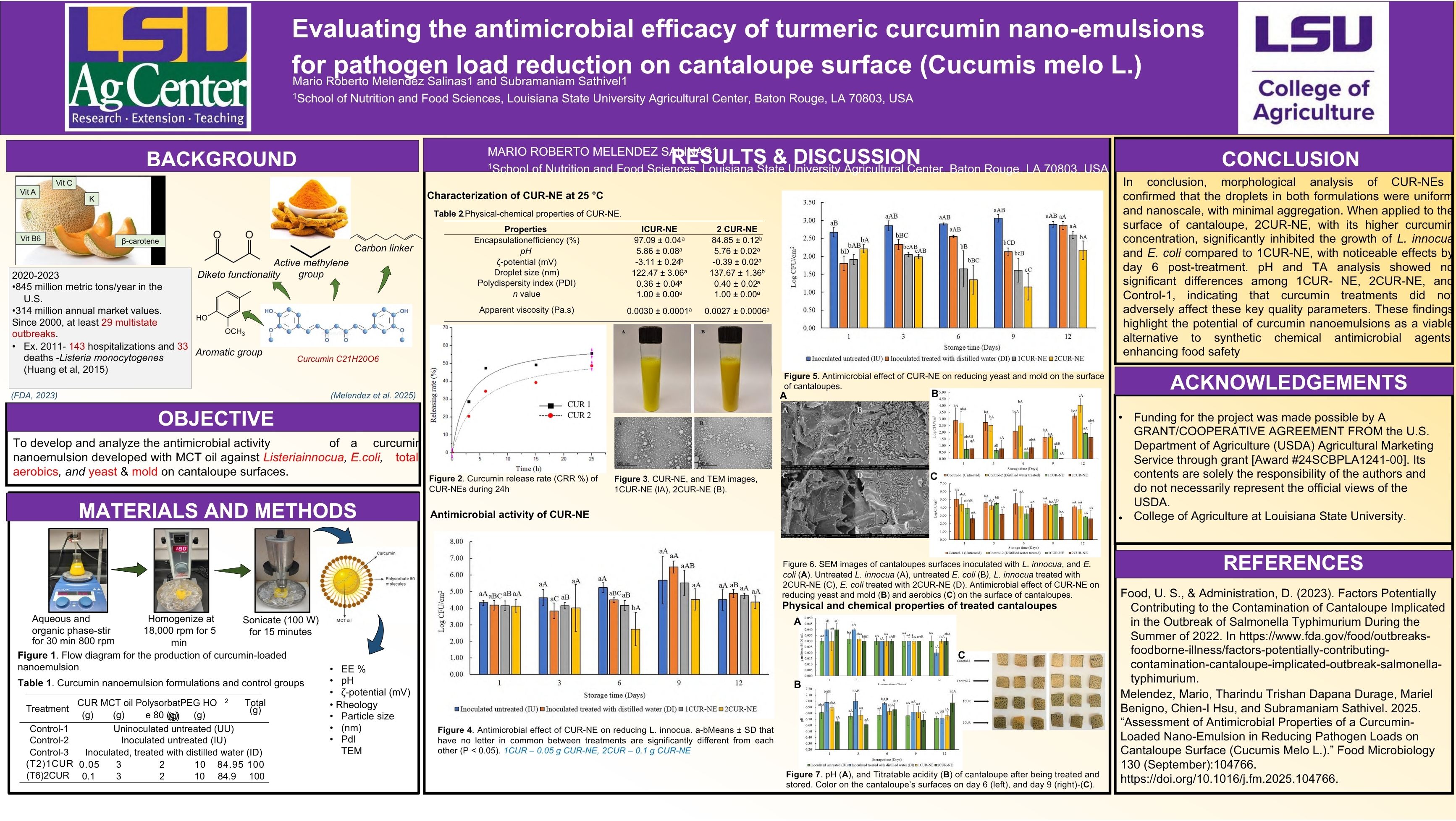



Mario Melendeza, Subramaniam Sathivela,b, *
a School of Nutrition and Food Sciences, Louisiana State University Agricultural Center, Baton Rouge, LA, 70803-4300, USA
b Department of Biological and Agricultural Engineering, Louisiana State University Agricultural Center, Baton Rouge, LA, 70803-4300, USA
*Corresponding author: School of Nutrition and Food Sciences, 220 H.D. Wilson Laboratories, Louisiana State University Agricultural Center, Baton Rouge, LA 70803, USA.
Curcumin (CUR), known for its antimicrobial properties, is ahydrophobic polyphenol derived from the widely consumed spice turmeric, but its practical use is limited due to its chemical instability. This article explores the potential application of curcumin nanoemulsions (CUR-NEs) in enhancing the microbial safety of fresh produce, with particular emphasis on their antibacterial activity against L. monocytogenes, E. coli, aerobic bacteria, yeasts, and molds. Studies evaluating their effectiveness on produce surfaces, such as cantaloupe, during storage are discussed. The article highlights that physically, the CUR-NEs have low viscosities and small droplet sizes, supporting their stability and potential applications. Overall, CUR-NEs, particularly the higher concentration formula, shows promise as a natural alternative to synthetic antimicrobials for improving food safety. However, additional research is needed to confirm its long-term use and effectiveness across various food systems.

Cantaloupe (Cucumis meloL.) ranks among the most widely consumed fruits in the United States. In 2022, approximately 1,073 million pounds of cantaloupe were cultivated domestically, complemented by an additional 786 million pounds imported to meet consumer demand (Weber et al, 2023). Despite its nutritional advantages and market appeal, cantaloupe has emerged as a critical concern regarding food safety. Its association with multiple foodborne illness outbreaks over the past several decades highlights the vulnerability of this fruit to microbial contamination.While E. coli has contributed to numerous cases of illness and hospitalization, L. monocytogenes has been particularly deadly, as evidenced by a 2011 multistate outbreak that resulted in 33 confirmed fatalities.
Aqueous sanitizers, particularly those based on chlorine, have become the most widely adopted post harvest decontamination method. Alternative chemical treatments such as peracetic acid and quaternary ammonium compounds have also been used with varying degrees of success (Silveira et al., 2008). However, the efficacy of these sanitizers is often compromised by their interactions with organic matter present in wash water, leading to the rapid degradation of the active agents and reduced antimicrobial effectiveness.
Given the limitations and potential hazards associated with chemical sanitizers, researchers have turned their attention to alternative and emerging technologies. Curcumin, a bioactive polyphenolic compound derived from Curcuma longa (turmeric), has been extensively studied for its broad-spectrum antimicrobial properties. Numerous studies have demonstrated its effectiveness against a wide range of pathogens including bacteria, viruses, and fungi (Adamczak et al.,2020; Hussain et al., 2022; Dai et al.,2022). However, despite its potential, the direct application of curcumin in food systems remains challenging due to its poor water solubility (11 ng/mL), chemical instability, and limited bioavailability (Tønnesen et al., 2002).
Given the significant public health risks associated with cantaloupe contamination and the limitations of current decontamination strategies, there is a clear need for novel, natural, and effective antimicrobial interventions that are suitable for use in food systems. This review investigates the potential application of curcumin nanoemulsions in enhancing the microbial safety of fresh produce, with particular emphasis on their antibacterial activity against L. monocytogenes, E.coli, aerobic bacteria, yeasts, and molds. Studies evaluating their effectiveness on produce surfaces, such as cantaloupe, during storage are discussed.
Melendez et al.(2025) have developed a turmeric-derived curcumin nanoemulsion (CURNE) evaluated to determine its effectiveness in inhibiting microbial growth of L. innocua and E.coli on the surface of fresh cantaloupe (Cucumismelo L.). The work offers critical insights into the nanoemulsion’s formulation, stability, and antimicrobial potential, which are detailed below.
Melendez et al. (2025) have reported the development of two curcumin nanoemulsions containing 0.05% and 0.10% (w/w)curcumin, designated as 1CUR-NE and 2CUR-NE, respectively. The oil phase comprises medium-chain triglyceride (MCT) oil, while Polysorbate 80 (Tween 80) and polyethylene glycol 400 (PEG 400) are used as the surfactant and co-surfactant. The preparation process involves dissolving curcumin in MCT oil (3% w/w), followed by gradual incorporation into an aqueous phase containing 2% Tween 80, 10% PEG 400, and water, under continuous stirring. The resulting pre-emulsion undergoes high-shear homogenization and is subsequently refined using probe sonication. To prevent thermal degradation of curcumin, the sonication step is performed in an ice bath. The final nanoemulsions are stored at 4 °C prior to analysis.
Melendez et al.(2025) use dynamic light scattering (DLS) analysis to measure particle size, revealing that 1CUR-NE exhibits a smaller and more uniform particle size compared to 2CUR-NE, with some evidence of aggregation. Zeta potential (ζ-potential) analysis shows a significant (p < 0.05) difference in surface charge between the two formulations: 1CUR-NE displays a more negative ζ-potential, while 2CUR-NE approaches a near-neutral charge. The authors suggest that this difference in surface charge may influence antimicrobial activity by modulating electrostatic interactions between nanoemulsion droplets and bacterial cell membranes.
Encapsulation efficiency (EE%) is another key parameter evaluated by Melendez et al. (2025) and they have reported that 1CUR-NE achieves a significantly higher EE% compared to 2CUR-NE, indicating more stable encapsulation at the lower curcumin concentration. Rheological characterization shows that both nanoemulsions exhibit comparable viscosity profiles. These findings highlight the potential of CUR-NEs for application on fresh produce, where stable flow behavior is essential for achieving uniform surface coverage.
In their antimicrobial assessment, Melendez et al. (2025) use fresh cantaloupes that are washed, dried, and cut into 2 cm × 2 cm rind sections. The samples are inoculated with suspension of either L. innocua or E. coli, followed by air drying. Each sample is then treated with either 1CUR-NE or 2CUR-NE, evenly spread across the surface, while untreated samples serve as controls. All samples are stored at 4 °C, and microbial populations are counted on days 0, 3, 6, 9, and 12. Melendez et al. (2025) conclude that both formulations are more effective against E.coli than L. innocua throughout the storage period, with 2CUR-NE exhibiting stronger and more prolonged antimicrobial effects. These findings suggest a dose-dependent response, where higher curcumin concentrations enhance antimicrobial performance, at least in the short term.
Further analyses conducted by Melendez et al. include morphological examination using scanning electron microscopy, which shows substantial reductions in bacterial presence on cantaloupe surfaces treated with 2CUR-NE. Moreover, this formulation significantly inhibits the growth of aerobic bacteria, yeasts, and molds, particularly during the first three days of storage. Although some microbial regrowth occurs by day 12, both CUR-NEs consistently outperform the untreated controls. Color measurements suggest that CUR-NEs-treated cantaloupes retain a fresher visual appearance. Importantly, no adverse effects are observed on pH or titratable acidity (TA), indicating that curcumin treatments do not compromise key quality attributes of the fruit.
In summary, Melendez et al. (2025) have demonstrated that curcumin nanoemulsions, particularly at higher concentrations, possess considerable antimicrobial potential for application in fresh produce. Their work supports the development of natural antimicrobial agents to enhance food safety and shelf life. They have also suggested that future work should focus on improving storage stability of the nanoemulsions, including freeze-drying, and evaluating their performance in broader food system applications.
This summary article is based on the original research titled “Assessment of antimicrobial properties of a curcumin-loaded nano-emulsion in reducing pathogen loads on cantaloupe surface (Cucumis melo L.)”, which was originally published in the journal Food Microbiology (DOI:10.1016/j.fm.2025.104766). This summary is intended for dissemination through the 3-A SSI blog and LinkedIn page, and any reuse or citation should refer to the original peer-reviewed publication.
Funding for the publication “Assessment of Antimicrobial Properties of a Curcumin Loaded Nano-emulsion in Reducing Pathogen Loads on Cantaloupe Surface (Cucumis meloL.)” was made possible by A GRANT/ COOPERATIVE AGREEMENT FROM the U.S. Department of Agriculture (USDA) Agricultural Marketing Service through grant [Award #21SCBPLA124100]. Its contents are solely the responsibility of the authors and do not necessarily represent the official views of the USDA.
Adamczak, A., Ożarowski, M., & Karpiński, T. M. (2020). Curcumin, a Natural Antimicrobial Agent with Strain-Specific Activity. Pharmaceuticals, 13(7), 153. https://doi.org/10.3390/ph13070153
Dai, C., Lin, J., Li, H., Shen, Z., Wang,Y., Velkov, T., & Shen, J. (2022). The Natural Product Curcumin as an Antibacterial Agent: Current Achievements and Problems. Antioxidants, 11(3), 459. https://doi.org/10.3390/antiox11030459
Hussain, Y., Alam, W., Ullah, H., Dacrema, M., Daglia, M., Khan, H., & Arciola, C. R. (2022). Antimicrobial Potential of Curcumin: Therapeutic Potential and Challenges to Clinical Applications. Antibiotics, 11(3), 322. https://doi.org/10.3390/antibiotics11030322
Melendez, M., Dapana Durage, T. T., Benigno, M., Hsu, C.-I.,& Sathivel, S. (2025). Assessment of antimicrobial properties of a curcumin-loaded nano-emulsion in reducing pathogen loads on cantaloupe surface (Cucumis melo L.). Food Microbiology, 130, 104766. https://doi.org/10.1016/j.fm.2025.104766
Silveira, A. C., Conesa, A., Aguayo, E., & Artes, F. (2008). Alternative Sanitizers to Chlorine for Use on Fresh‐Cut “Galia” ( Cucumis melo var. catalupensis ) Melon. Journal of Food Science, 73(9). https://doi.org/10.1111/j.1750-3841.2008.00939.x
Tønnesen, H. H., Másson, M., & Loftsson, T. (2002). Studies of curcumin and curcuminoids. XXVII. Cyclodextrin complexation: solubility, chemical and photochemical stability. International Journal of Pharmaceutics, 244(1–2), 127–135. https://doi.org/10.1016/S03785173(02)00323-X
Weber, C. S. S. G. L. and W. V. D. (2023, March 30). Fruit and TreeNuts Outlook: March 2023. FTS-376, U.S. Department of Agriculture, Economic Research Service.
Do you know a student in food safety, equipment design or a related field? The application for the Dr. Ron Schmidt Student Travel Award is available now on the new 3-A SSI Student resources page. In addition to information on the award, the page includes curated resources to help students build their expertise and launch a career in food safety and equipment design.

3-A SSI has launched an all-new program to recognize rising stars under the age of 40.

3-ASSI has launched an all-new Student Hygienic Design Competition. It gives students an opportunity to launch their careers while competing as part of an interdisciplinary team for bragging rights and a share of $10,000 in prize money.

The application is open for the 3-A SSI Dr. Ron Schmidt Student Travel Award. Recipients attend the 3-A SSI 2026 Summit on Hygienic Design, present a poster, and are treated to a VIP experience. After the event, recipients' research is published on the 3-A blog and promoted on social media. Many students land internships or full-time jobs as a result of the recognition.

After a productive and engaging PACK EXPO, the 3-A SSI team turns its sights to EATS and the IDFA DairyTech Conference.